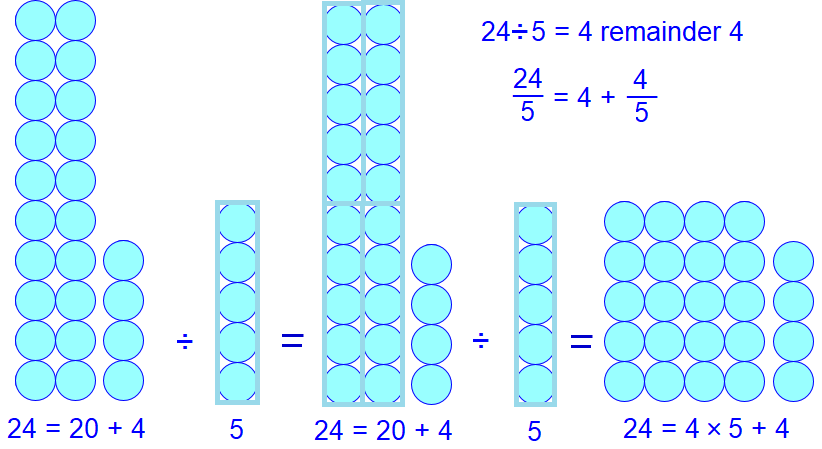Calculating with numbers: Computing with integers
 Division with remainder
Division with remainder
A division with no remainder When you fairly share \(24\) marbles amongst \(6\) children, you give share each child \(4\) marbles and you get rid of all marbles; after all, \(6\times 4=24\). To calculate how many marbles you can give to each child you divide \(24\) by \(6\); in arithmetic language you write on \(24:6=4\) and pronounce it as "twenty-six divided by six equals four".
Euclidean division But can you do if you want to fairly share \(24\) marbles amongst \(5\) children? Even in this case you can start with giving each child \(4\) marbles. Then you have already shared \(5\times 4=20\) marbles, but there are still \(4\) marbles left in your hands. If these remaining marbles are not given away through a lottery, you are left with the remaining marbles. In arithmetic language you write \(24:5=4\textit{ remainder }4\) and pronounce it js "twenty divided by five equals four with a remainder of four."
This process of division in which a nonzero remainder is possible is called division with remainder or Euclidean division. In this example we call
- the number of marbles the dividend;
- the number of children who get the marbles divisor;
- the number of marbles that every child gets the quotient;
- the remaining number of marbles is the remainder.
The following theorem makes mathematically more precise what we mean by division with remainder.
Division with remainder If \(a\) and \(b\) are natural numbers and \(b>0\), then there are unique natural numbers \(q\) and \(r\) such that \[a=q \times b+r\qquad\text{and}\qquad 0\le r<b\text.\] We call \(q\) the quotient and \(r\) the remainder of the division with remainder of \(a\) by \(b\).
The number \(a\) is called divisible by \(b\) when the remainder is equal to zero. In this case, we say that "the division terminates" and that "\(b\) is a divisor of \(a\)".
Long division is the fastest and most systematic approach to pencil-and-paper calculations of the outcome of a division or a division with remainder. The example below illustrates this.
Example of long division \[\begin{array}[t]{rrl}
36\; \Bigm/ \!\!\! & 81218 & \!\!\! \Bigm{\backslash} \; 2256 \\
& \underline{72}\phantom{000} & \qquad \blue{\uparrow}\\
& \phantom{0}92\phantom{00} & \blue{\text{quotient}}\\
& \phantom{0} \underline{72}\phantom{00} & \\
& \phantom{0}201\phantom{0} & \\
& \phantom{0}\underline{180}\phantom{0} & \\
& \phantom{00}218 & \\
& \phantom{00}\underline{216} & \\
& \phantom{0000}2 & \blue{ \leftarrow \text{remainder}}
\end{array}\] So: \[81218= 2256\times 36 +2 \qquad\text{and}\qquad 81218:36 = 2256\textit{ remainder }2\] This implies the following exact calculation of the divsion: \[81218:36 =2256\,\tfrac{2}{36}=2256\,\tfrac{1}{18}\]
Instructional videos in Dutch from Stichting Goed Rekenonderwijs



